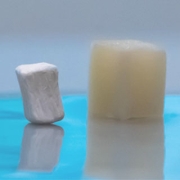Wood pieces at different stages of modification,
from natural (far right) to MOF-infused functional wood (far left)
(Credit: Gustavo Raskosky/ Rice University)
An engineered wood material that could be used in construction has been modified to capture carbon dioxide.
The reportedly energy-efficient process, which also makes the material stronger, was developed by researchers at Rice University in Texas.
Structural materials like steel or cement come at a high cost, both in money and CO2 emissions – building construction and use accounts for an estimated 40% of emissions. Developing sustainable alternatives to existing materials could help mitigate climate change and reduce emissions.
Working to address both issues at once, materials scientist Muhammad Rahman and colleagues found a way to incorporate molecules of a CO2-trapping crystalline porous material into wood.
“Wood is a sustainable, renewable structural material that we already use extensively,” Rahman said. “Our engineered wood did exhibit greater strength than normal, untreated wood.”
In the conversion process, the network of cellulose fibres that gives wood its strength is first cleared out through a process known as delignification.
“Wood is made up of three essential components: cellulose, hemicellulose and lignin,” Rahman said. “Removing the lignin is a fairly simple process that involves a two-step chemical treatment using environmentally benign substances. After removing the lignin, we use bleach or hydrogen peroxide to remove the hemicellulose.”
Next, the delignified wood is soaked in a solution containing microparticles of a metal-organic framework (MOF), known as Calgary framework 20 (CALF-20). MOFs are high-surface area sorbent materials used for their ability to adsorb CO2 molecules into their pores.
“The MOF particles easily fit into the cellulose channels and get attached to them through favourable surface interactions,” said Soumyabrata Roy, lead author on the study.
MOFs are among several nascent carbon capture technologies developed to address climate change. “Right now, there is no biodegradable, sustainable substrate for deploying carbon dioxide-sorbent materials,” Rahman said. “Our MOF-enhanced wood is an adaptable support platform for deploying sorbent in different carbon dioxide applications.”
“Many of the existing MOFs are not very stable in varying environmental conditions,” Roy added. “Some are very susceptible to moisture, and you don’t want that in a structural material.”
CALF-20, developed by University of Calgary Professor George Shimizu and colleagues, stands out in both performance and versatility under a variety of environmental conditions, Roy said.
“The manufacturing of structural materials such as metals or cement represents a significant source of industrial carbon emissions,” Rahman said. “Our process is simpler and ‘greener’, in terms of both substances used and processing byproducts.
“The next step would be to determine sequestration processes as well as a detailed economic analysis to understand the scalability and commercial viability of this material.”



